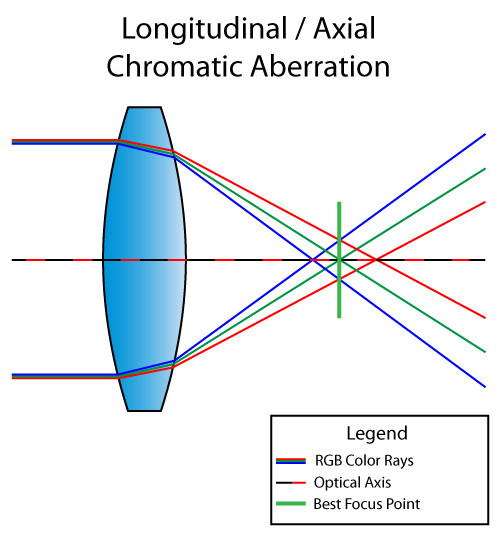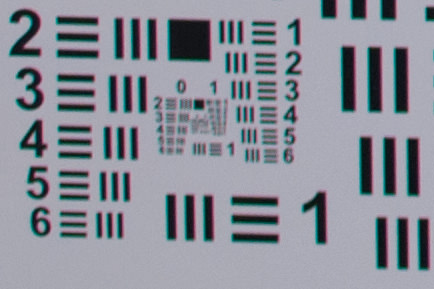What is Chromatic Aberration?
2015-12-14 22:03
239 查看
转一篇关于透镜色差的文章。玩单反的人都知道,有个关于镜头的专业术语叫紫边,其实紫边现象就是色差的一种表现。
而VR里面的后处理可能会涉及到这方面的知识;因为头戴式的VR眼镜里也有一对透镜。
色差(又称为“色散现象”)是由于照相机的镜头没有把不同波长的光线聚焦到同一个焦平面(不同波长的光线的焦距是不同的),或者和镜头对不同波长的光线放大的程度不同而形成的。色差又可分为“纵向色差”和“横向色差”,色差的程度随着镜头表明玻璃的色散程度不同而有所差异。


纵向色差,不同颜色光线的波长不同,焦距也不同;横向色差,不同颜色光线波长不同,放大倍率也不同。
NOVEMBER 8, 2011 BY NASIM MANSUROV31
COMMENTS
[align=center][/align]
Chromatic Aberration, also known as “color fringing” or “purple fringing”, is a common optical problem that occurs when a lens is either unable to bring all wavelengths of color to the same focal plane, and/or when wavelengths of color are focused at different
positions in the focal plane. Chromatic aberration is caused by lens dispersion, with different colors of light travelling at different speeds while passing through a lens. As a result, the image can look blurred or noticeable colored edges (red, green, blue,
yellow, purple, magenta) can appear around objects, especially in high-contrast situations.
A perfect lens would focus all wavelengths into a single focal point, where the best focus with the “circle of least confusion” is located, as shown below:

In reality, the refractive index for each wavelength is different in lenses, which causes two types of Chromatic Aberration – Longitudinal Chromatic Aberration and Lateral Chromatic Aberration.
Longitudinal Chromatic Aberration, also known as “LoCA” or “bokeh fringing”, occurs when different wavelengths of color do not converge at the same point after passing through a lens, as illustrated below:

Lenses with Longitudinal Chromatic Aberration problems can show fringing around objects throughout the image, even in the center. Red, Green, Blue or a combination of these colors can appear around objects. Longitudinal Chromatic Aberration can be dramatically
reduced by stopping down the lens. Fast aperture prime lenses are typically much more prone to LoCA than slower lenses.
Here is an example of longitudinal chromatic aberration that is visible at different distances:

NIKON D3S + 35mm f/1.4 @ 35mm, ISO 200, 1/320, f/1.4
Note the green color on the top of the image, transforming to neutral in the middle, then becoming purple on the bottom part of the image that is closer to the camera. This kind of longitudinal chromatic aberration is present even on high-end, expensive lenses
like the Nikon 35mm f/1.4G. This type of LoCA / bokeh fringing can be significantly
reduced in post-processing. For example, Lightroom 4.1 has the “De-Fringe tool”, which allows one to select an eye dropper under the “Lens Corrections” module and pick a fringe color that needs to be corrected. With such tool, one can either completely eliminate
this type of fringing or reduce it significantly.
Here is another example of longitudinal chromatic aberration with green and purple fringing, visible on both sides of the tree trunks and branches:

The bottom crop was corrected in Lightroom’s “Lens Corrections” sub-module
with a single click. The same can be done in Photoshop, but involves more steps (if not using the Camera RAW tool).
Lateral Chromatic Aberration, also known as “transverse chromatic aberration”, occurs when different wavelengths of color coming at an angle focus at different positions along the same focal plane, as illustrated below:

Unlike LoCA, Lateral Chromatic Aberration never shows up in the center and is only visible towards the corners of the image in high-contrast areas. Blue and purple fringing is often common on some fisheye, wide-angle and low-quality lenses. Unlike Longitudinal
Chromatic Aberration, Lateral Chromatic Aberration cannot be removed by stopping down the lens, but can be removed or reduced in post-processing software.
Here is a corner crop from the Nikon 35mm f/1.8G lens that has a rather severe amount of lateral CA in the corners:

Unfortunately, many lenses have both longitudinal and lateral chromatic aberrations present at the same time. The only way to reduce these aberrations, is to stop down the lens (to reduce LoCA) and then fix lateral CA in post-processing software like Lightroom
and Photoshop.
While many modern lens manufacturers employ specific techniques to reduce chromatic aberrations using achromatic/apochromatic optical designs and special extra-low dispersion elements, chromatic aberration is still an issue on most prime and zoom lenses that
we just have to learn how to get around with. The good news is that many modern DSLRs incorporate special in-camera post-processing techniques to reduce and even eliminate lens chromatic aberrations and plenty of software packages are also capable of dealing
with chromatic aberrations.
而VR里面的后处理可能会涉及到这方面的知识;因为头戴式的VR眼镜里也有一对透镜。
色差(又称为“色散现象”)是由于照相机的镜头没有把不同波长的光线聚焦到同一个焦平面(不同波长的光线的焦距是不同的),或者和镜头对不同波长的光线放大的程度不同而形成的。色差又可分为“纵向色差”和“横向色差”,色差的程度随着镜头表明玻璃的色散程度不同而有所差异。


纵向色差,不同颜色光线的波长不同,焦距也不同;横向色差,不同颜色光线波长不同,放大倍率也不同。
What is Chromatic Aberration?
NOVEMBER 8, 2011 BY NASIM MANSUROV31COMMENTS
[align=center][/align]
Chromatic Aberration, also known as “color fringing” or “purple fringing”, is a common optical problem that occurs when a lens is either unable to bring all wavelengths of color to the same focal plane, and/or when wavelengths of color are focused at different
positions in the focal plane. Chromatic aberration is caused by lens dispersion, with different colors of light travelling at different speeds while passing through a lens. As a result, the image can look blurred or noticeable colored edges (red, green, blue,
yellow, purple, magenta) can appear around objects, especially in high-contrast situations.
A perfect lens would focus all wavelengths into a single focal point, where the best focus with the “circle of least confusion” is located, as shown below:

In reality, the refractive index for each wavelength is different in lenses, which causes two types of Chromatic Aberration – Longitudinal Chromatic Aberration and Lateral Chromatic Aberration.
Longitudinal Chromatic Aberration
Longitudinal Chromatic Aberration, also known as “LoCA” or “bokeh fringing”, occurs when different wavelengths of color do not converge at the same point after passing through a lens, as illustrated below:
Lenses with Longitudinal Chromatic Aberration problems can show fringing around objects throughout the image, even in the center. Red, Green, Blue or a combination of these colors can appear around objects. Longitudinal Chromatic Aberration can be dramatically
reduced by stopping down the lens. Fast aperture prime lenses are typically much more prone to LoCA than slower lenses.
Here is an example of longitudinal chromatic aberration that is visible at different distances:

NIKON D3S + 35mm f/1.4 @ 35mm, ISO 200, 1/320, f/1.4
Note the green color on the top of the image, transforming to neutral in the middle, then becoming purple on the bottom part of the image that is closer to the camera. This kind of longitudinal chromatic aberration is present even on high-end, expensive lenses
like the Nikon 35mm f/1.4G. This type of LoCA / bokeh fringing can be significantly
reduced in post-processing. For example, Lightroom 4.1 has the “De-Fringe tool”, which allows one to select an eye dropper under the “Lens Corrections” module and pick a fringe color that needs to be corrected. With such tool, one can either completely eliminate
this type of fringing or reduce it significantly.
Here is another example of longitudinal chromatic aberration with green and purple fringing, visible on both sides of the tree trunks and branches:

The bottom crop was corrected in Lightroom’s “Lens Corrections” sub-module
with a single click. The same can be done in Photoshop, but involves more steps (if not using the Camera RAW tool).
Lateral Chromatic Aberration
Lateral Chromatic Aberration, also known as “transverse chromatic aberration”, occurs when different wavelengths of color coming at an angle focus at different positions along the same focal plane, as illustrated below:
Unlike LoCA, Lateral Chromatic Aberration never shows up in the center and is only visible towards the corners of the image in high-contrast areas. Blue and purple fringing is often common on some fisheye, wide-angle and low-quality lenses. Unlike Longitudinal
Chromatic Aberration, Lateral Chromatic Aberration cannot be removed by stopping down the lens, but can be removed or reduced in post-processing software.
Here is a corner crop from the Nikon 35mm f/1.8G lens that has a rather severe amount of lateral CA in the corners:

Unfortunately, many lenses have both longitudinal and lateral chromatic aberrations present at the same time. The only way to reduce these aberrations, is to stop down the lens (to reduce LoCA) and then fix lateral CA in post-processing software like Lightroom
and Photoshop.
While many modern lens manufacturers employ specific techniques to reduce chromatic aberrations using achromatic/apochromatic optical designs and special extra-low dispersion elements, chromatic aberration is still an issue on most prime and zoom lenses that
we just have to learn how to get around with. The good news is that many modern DSLRs incorporate special in-camera post-processing techniques to reduce and even eliminate lens chromatic aberrations and plenty of software packages are also capable of dealing
with chromatic aberrations.
相关文章推荐
- iOS开发之GData
- Kurento应用开发指南(以Kurento 5.0为模板) 之二:示例教程helloworld
- Spinner的使用
- logHelp日志代码分析
- URL之Linux相关资源整理
- JQuery 如何选择带有多个class的元素
- [leetcode] 134. Gas Station
- mysql数据库的一些基本操作
- Android-JNI(1)-简介
- OTO电子商务商业模式探析
- 以软件开发生命周期来说明不同的测试使用情况
- 中点算法绘制椭圆_程序
- Mac下配置PHP+Apache+phpMyAdmin+MySql远程链接
- jQuery 多个 classes 选择器
- Qt图形视图QGraphicsItem类
- iptables 状态策略 允许内网连接外网 拒绝外网主动连入内网
- 分享一个前端验证插件
- 社交网络节点理论
- iOS开发之EGOImageLoading
- Kurento应用开发指南(以Kurento 5.0为模板) 之一:简介,安装与卸载
